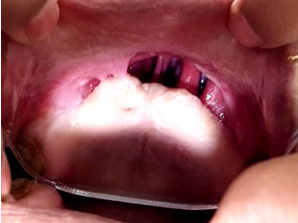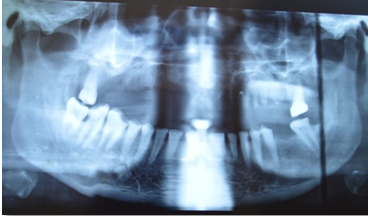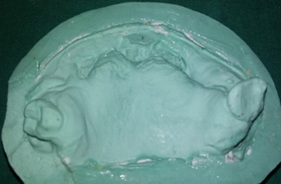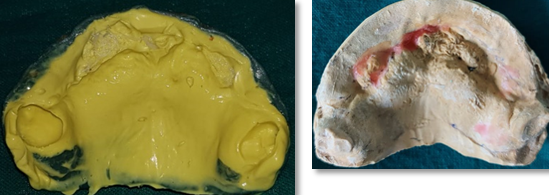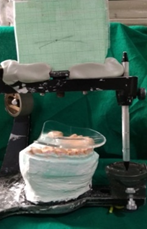Introduction
Creating beautiful smile with function is primary aim of a maxillofacial prosthodontist. After loss of maxillofacial structures like extra oral facial parts and intraoral facial parts, the patient faces severe mental trauma. There will be problem in speech, esthetics and mastication. The society will not accept the patient having maxillofacial defects. The maxillofacial prosthodontist play a major role in reconstruction of lost part with the maxillofacial prosthesis.
Maxillofacial structures may loss due to many causes like congenital, accidental and neoplasm.
Due to drug or nicotine, the problem of neoplasm in oral tissues are most commonly seen. After ablative surgery of the neoplasm, there will be a defect on palate, creates oro-antral communication, patient will not be able to eat or drink with improper phonetics. The prosthetic treatment option for palatal defect is obturator.1, 2
Obturators given for kids are basically a feeding appliance and for adults there will be three types of obturators; surgical, Interim and definitive. Surgical obturator is used to restore the continuity of hard palate immediately after surgery or traumatic loss of a portion or all of the hard palate and /or contiguous alveolar structures like gingival tissue, teeth.3
The interim obturator is made several weeks or month following surgical resection of a portion of one or both maxillae. It frequently includes replacement of teeth in defect area. This prosthesis when used, replaces the surgical obturator that is placed immediately following the resection and may be subsequently replaced with a definitive obturator. A definitive obturator artificially replaces part or all of the maxilla and the associated teeth lost due to surgery or trauma.3, 4
In this case report step by step management of a maxillectomy patient with interim hollow bulb obturator is described.
Case Report
A 68 year old patient is reported to the Department of Prosthodontics, Career Post Graduate Institute of Dental Sciences and Hospital, Lucknow with a chief complaint of missing teeth, difficulty in eating and speech since 6 years. Medical history revealed that the patient has history of usage of medicament containing arsenic leading to infection of pre-maxilla and underwent resection surgery for the same. Past dental history revealed extraction of some mandibular teeth and some maxillary teeth. A intraoral examination revealed a defect in pre-maxillae region. On clinical examination the defect was classified as Armany’s class 6 defect. Patient had missing all maxillary teeth except 18, 28 and only missing 36 in mandibular arch. After discussing all treatment options, patient was agreed for maxillary interim hollow bulb obturator.(Figure 1, Figure 2)
Treatment procedures
First, an impression was made with irreversible hydrocolloid was poured with dental stone and cast was retrieved2. Before taking the impression, the defective area was blocked with gauge piece and a thread was attached on it so that it will not go inside the defective area. Border molding and secondary impression was taken with green stick and light body addition silicon impression material. Master cast was retrieved and above it occlusal rim was fabricated. After jaw relation and face bow transfer, teeth arrangement and try-in done.4 Next, a hollow bulb obturator using Adams clasp engaging the 2nd molar bilaterally, undercut areas and scar of defect was processed in heat-cured acrylic resin.
Processing of Hollow bulb part of the obturator
The denture was processed in a curing flask. The hollow bulb obturator was fabricated using the lost salt technique. First of all, processing was completed, and then salt was removed by a water jet. The bulb part of the obturator made hollow to decrease the weight of the obturator. The open area of the bulb was closed using auto-polymerizing resin. After setting of auto-polymerizing resin, finishing and polishing of obturator was completed and delivered to the patient.
Post operative instructions were given to patient and regular follow-up schedule was planned. Patient was fully satisfied with the prosthesis.(Figure 3, Figure 4, Figure 5, Figure 6, Figure 7)
After surgical removal of neoplastic lesion from premaxilla/palate area, the patient have many problems, the speech, mastication ability, phonetics is severly affected. There is immediate requirment of surgical obturator, which helps in healing and assist patient for taking diet. Main disadvantage of surgical obturators are that it does not have any teeth and also not support the oral musculature. So after 1 month of surgery, patient is advised for interim hollow bulb obturator on premailla region of defect. Hollow bulb obturator have teeth and flange so as to support the oral musculature and start the chewing function; mastication and deglutition.5, 6, 7
If the remaining maxillary segment is edentulous, securing retention for the prosthesis is more difficult than in a dentate patient. The retentive capabilities of the residual maxillary segment must be evaluated by using the same factors that contribute to the acceptable retention of a conventional complete denture including the physical properties of adhesion, cohesion, atmospheric pressure, and interfacial surface tension.8, 9, 10
Many techniques have been advocated for processing of hollow bulb obturators. The commonly used materials are ice, salt, sugar, silicon rubber, wax shim. These materials are removed by making a hole after processing of the obturators.10
Malaton and La Fuente described the technique of adding sugar during processing of the obturator, which is later removed by drilling a hole in the superior surface and the hole is filled with autopolymerising resin. El Mahdy et al described the two flask technique to process the obturator and the tooth portion separately. Mc Andrew et al described the technique of fabricating the prosthesis in two halves and sealing them using auto-polymerising resin.
In this case report last salt technique was used to make hollow bulb obturator. This technique was simple and less time taking. After processing a hole is created in bulb part of the obturator and salt is removed by using water jet. After removing the salt, the obturator became hollow. Hole was sealed with auto-polymerizing resin.11
In this case interim hollow bulb obturator was given to improve the form and fucntion with proper esthetics. Hollow bulb part of the obturator made the prosthesis light weighted and provided adequete support. Adams clasp was added to achieve adequate retention from posterior remaining teeth.11, 12, 13, 14
Conclusion
The maxillofacial defect needs to be cured immediately. After maxillofacial surgical treatment, patient is suffering from physcological trauma. Maxillofacial prosthodontist will play a key role in management of maxillofacial defects. Intra-oral palatal defects should be treated meteculously as patients is having problem in chewing and deglutution. Hollow bulb-obturator prosthesis is proved for providing good results in palatal defects cases.14


